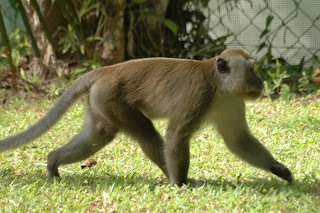We expected(hoped actually) to just see a couple of Oriental pied hornbills at Sebana since they have been spotted there on previous occassions. But.. surprise surprise! 'Someone' else came along to join the party :)
Oriental Pied Hornbill (Anthracoceros albirostris)

We heard the Oriental pied before we actually saw it. Seems to happen with birds a lot. And just when you start to think nope, these birds don't look all that strange, that they actually look quite nice, they open their mouths(or rather bills) and out comes that awful noise! It sounds like witches cackling! That is, if witches existed and they cackled, of course.
They call for various reasons, just as we open our mouths and emit sounds for various reasons. Some of the reasons they call out include the following: when they are frightened, during courtship feeding, to mark out their territories, and to attract their 'soulmates' even. Also just like us, these calls do not all sound the same, or there would be no point in making these calls for none would be able to make out what it's trying to say! It is possible that their casques(the strange protrusions at the top of their bills) help to make their calls as loud as
hornbilly possible.
Oriental Pied Hornbill (Anthracoceros albirostris)

The hornbill in the above picture initially presented a bit of a problem for us. It looked like a stereotypical Oriental pied hornbill except for... its tail! This seemingly strange bird didn't have the black tail with a white tip characteristic of this species of hornbill! But apparently, within the species there's quite a bit of variation in colour. There are 2 types(subspecies) of Oriental pied hornbill. The
convexus subspecies is apparently known to have more white tail feathers- the cause of our confusion. It is believed that this species loses some of its black tail feathers as it gets older. Which would mean that we have an oldie here :) A classic case of 'just when you think you have it all figured out, something happens to throw you off'.
Lesson of the day: No matter how much you think you know, the reality is, you don't know squat!
Oriental Pied Hornbill (Anthracoceros albirostris)

It's eating something red, and round. The fruit of a MacArthur palm perhaps? Though why it should grab the fruit and fly all the way to this tree to actually eat it we're not sure(presuming that it actually ate the fruit, since we didn't actually see it eat the fruit). Though there was a troop of long-tailed macaques creating a racket nearby. And this bird is known to be somewhat shy of these aggressive monkeys. Not a very good personality trait to have in the game of natural selection sometimes.
Another possibility: it is to be used to seduce another hornbill AKA, courtship feeding. *We're wiggling our collective eyebrows suggestively* Possibly to show that the hornbill can provide for its partner. The hornbill equivalent of "I'm tall, dark, handsome and rich, come have babies with me" perhaps? We prefer this second possibility, of course ;)
The next bird caused quite a bit of excitement, simply because it was the first of its kind we've ever seen! It was a good day. Or maybe we're just easily contented.
Female Black Hornbill (Anthracoceros malayanus)

The black hornbill is usually black all over except for a tinge of white at the tip of its tail. BUT... only the
female has a
black bill. The
male has a
yellow bill. We suspect that we might have seen a male, which was sitting on a tree close to this female. Unfortunately, he was camera and
Homo sapien shy so we couldn't get a picture of him and we're unable to confirm this. It was a game of chase the hornbill around the tree, and he had the upper hand(or should i say... upper wing?).
But if he is indeed a male... then they could be a breeding pair looking for a new property to raise the family and well, that's where we come into the picture :) It presents some very exciting possibilities. But of course, this is all purely speculation since we're not sure of his gender and species, so let's not get ahead of ourselves(though it is tempting...).
Female Black Hornbill snubbing us(Anthracoceros malayanus)

She didn't seem to take to being gawked at by upright walking apes apparently...
Reference
Kemp, A. (1995). The Hornbills. United States: Oxford University Press Inc., New York.





























